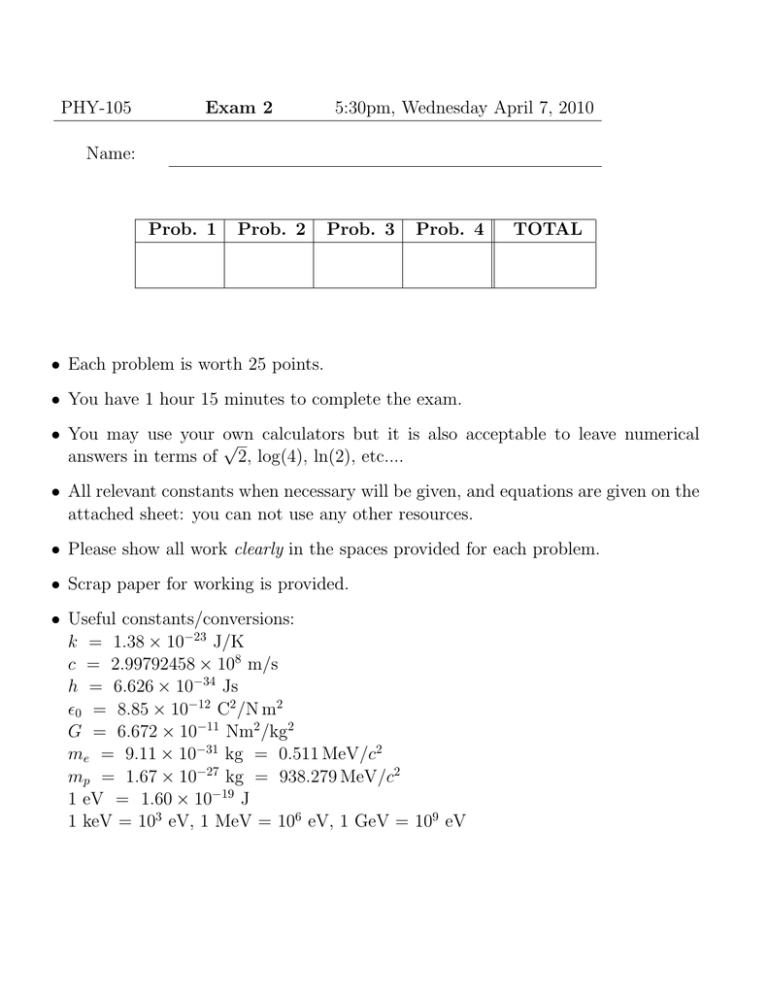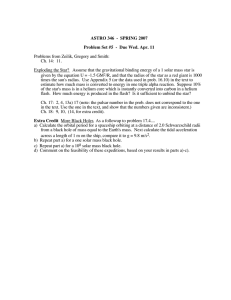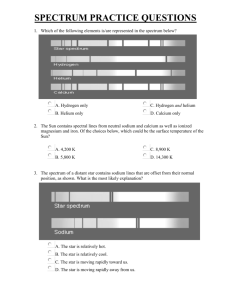PHY-105 Exam 2 5:30pm, Wednesday April 7, 2010 Name:
advertisement

PHY-105 Exam 2 5:30pm, Wednesday April 7, 2010 Name: Prob. 1 Prob. 2 Prob. 3 Prob. 4 TOTAL • Each problem is worth 25 points. • You have 1 hour 15 minutes to complete the exam. • You may use your own √ calculators but it is also acceptable to leave numerical answers in terms of 2, log(4), ln(2), etc.... • All relevant constants when necessary will be given, and equations are given on the attached sheet: you can not use any other resources. • Please show all work clearly in the spaces provided for each problem. • Scrap paper for working is provided. • Useful constants/conversions: k = 1.38 × 10−23 J/K c = 2.99792458 × 108 m/s h = 6.626 × 10−34 Js ǫ0 = 8.85 × 10−12 C2 /N m2 G = 6.672 × 10−11 Nm2 /kg2 me = 9.11 × 10−31 kg = 0.511 MeV/c2 mp = 1.67 × 10−27 kg = 938.279 MeV/c2 1 eV = 1.60 × 10−19 J 1 keV = 103 eV, 1 MeV = 106 eV, 1 GeV = 109 eV Problem 1 Discuss ONE of the following topics (within about 1 page): (A) The sequence of events believed to lead up to Type I and II supernovae. You can choose to either focus on one type of supernovae, or give less detail on both types. (B) The evolutionary stages after hydrogen burning for a star of mass greater than 25 M⊙ , giving rough estimates of the time spent in subsequent stages and why. (C) The Solar Neutrino Problem and its eventual solution. Give a clear introduction to your chosen topic, and be as quantitative as you can. Problem 2 Consider a spherically symmetric star in the early stages of its formation composed entirely of hydrogen gas of mass 2.0 × 1031 kg and a radius of Ri = 10R⊙ , where R⊙ = 7.0 × 108 m is the radius of the Sun. (a) [6 pts] Assuming the star has a constant luminosity of L = 4.0 × 1026 J/s due to the gravitational potential energy it loses as it collapses from 10R⊙ to R⊙ , estimate the time (in years) it takes to get to its radius of R⊙ . 2 (you ( The gravitational potential energy of a spherically symmetric mass M of radius r is Ug = − 35 GM r derived this in the last assignment). ) (b) [4 pts] At R⊙ the temperature in the core of the star becomes large enough for nuclear reactions to occur between the hydrogen nuclei (protons) producing energy, and hence a pressure gradient, that can support the star from further collapse. Estimate the core temperature at which this occurs. (c) [15 pts] If much later in the star’s lifetime the hydrogen in the core becomes depleted such that hydrogen burning can no longer sustain the pressure gradient needed for gravitational stability, estimate the temperature required for subsequent helium burning to occur, and estimate by how much the stars helium core will collapse (to what radius) before this temperature is reached in the core. (For the latter make the following approximations: the core is composed of the inner 10% of the star’s mass; the gas can be assumed to be ideal and obey the Maxwell-Boltzmann distribution; and 50% the energy lost from the gravitational collapse of the core goes into increasing the thermal energy of the particles in the core (with the rest being radiated away). Here only consider the collapse of the core, not what is happening to the outer layers, which is a whole other story. ) Problem 3 (a)[ 12 pts] Consider the three nuclear reactions in the PP I reaction chain: (1) 1 1H (2) (3) + 11 H → 21 H + e+ + νe 2 1H 3 2 He + 11 H → + 32 He → 3 2 He 4 2 He +γ + 2 11 H For each reaction calculate the energy released, Q1 , Q2 , and Q3 (in MeV). Assume the mass of the neutrino’s are zero. (Use: m(11 H) = mp = 1.6726 × 10−27 kg, mn = 1.6749 × 10−27 kg, m(21 H) = 2.0141u, m(32 He) = 3.0160u, m(42 He) = 4.00151u where 1u = 1.66054 × 10−27 kg = 931.494 MeV/c2 , me = 9.11 × 10−31 kg = 0.511 MeV/c2 ) (b) [5 pts] What is the total energy released from the entire PP I reaction chain in producing a single helium nucleus ? (c) [8 pts] Assuming the star in problem 2 is initially 100% hydrogen, and that only the inner 10% of the star’s mass is involved in the PP I chain in converting H to He, estimate the time (in years) this source of energy can maintain its luminosity of 4.0 × 1026 J/s. Problem 4 (a) [10 pts] Now consider the star in problem 2 and 3 to be in the later stages of its evolution when its core is almost entirely helium but not yet hot enough for helium to burn. Estimate the maximum fraction of the star’s total mass that can exist as an isothermal helium core. Assume that the core is entirely helium, the rest of the star is 75% hydrogen and 25% helium, and in both cases we have complete ionization. (b) [8 pts] This star will most likely end up as White Dwarf. What is the primary composition of the White Dwarf, and why. (c) [7 pts] Explain (in one or two sentences) what the source of the pressure is that will keep the White Dwarf stable from gravitational collapse. PHY-105 Exam 2 Formula Sheet u′k + v Relativistic velocity addition (parallel to moving frame) : uk = 1+ E = γmc2 (m 6= 0), E = vu′k c2 hc 1 (photons), E 2 = p2 c2 + m2 c4 , γ = q λ 1− v2 c2 Decay of particles with lifetime τ : N (t) = N0 et/τ s ∆λ = z= λ0 1+ 1− v c v c −1 For a neutral Hydrogen atom : En = − m M. − B. distribution function : nv dv = n 2πkT Boltzmann Equation : Ni+1 2kT Zi+1 Saha Equation : = Ni Pe Zi 3/2 13.6eV , gn = 2n2 n2 e −mv 2 /2kT 4πv 2 dv, vrms = s 3kT m gb Nb = e−(Eb −Ea )/kT Na ga 2πme kT h2 3/2 e−χ/kT , Z = g1 + ∞ X gj e−(Ej −E1 )/kT j=2 L F1 , m − M = 5 log d − 5 F = , m1 − m2 = −2.5 log 2 4πr F2 Equations of Stellar Structure : dP GMr ρ dMr dLr dT 3κLr ρ =− 2 , = 4πr2 ρ, = 4πr2 ρǫ, =− dr r dr dr dr 16πacr2 T3 A 2 Binding Energy for a nucleus A Z X is : Q = [Zmp + Nmn − m(Z X)]c Tquantum = Pe ≈ Kρ 5/3 , where, 1 µm Z12 Z22 e4 4 3 (4πǫ0 )2 kh2 K= 3 8π 2/3 Schonberg − Chandrasekhar limit : h2 5me Z 1 · A mH 5/3 Mic µe ≈ 0.37 M µic . 2



